Webb Photographs Newly Forming Stars in Incredible, Colorful Detail
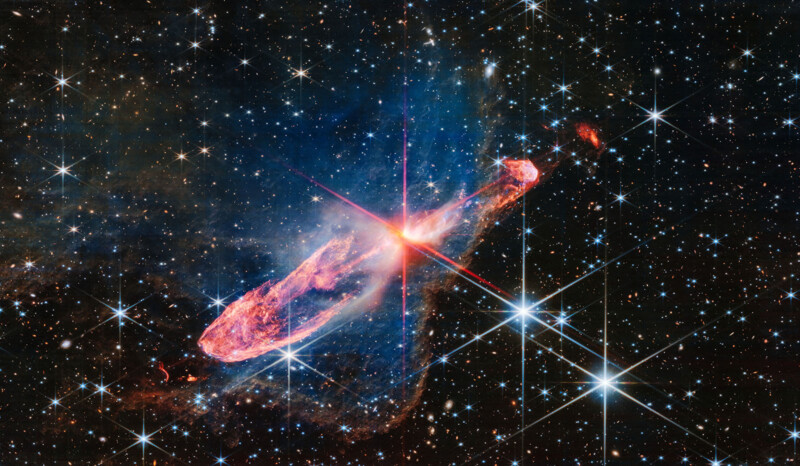
The James Webb Space Telescope has captured an amazing image of Herbig-Haro 46/47 using its near-infrared instrument, NIRCam. The image, processed by Joe DePasquale of the Space Telescope Science Institute (STScI), showcases a “tightly bound pair of actively forming stars” in brilliant detail and color.
As PetaPixel explored this week in the latest episode of the PetaPixel Podcast and an in-depth interview with DePasquale and his fellow image processor at STScI, Alyssa Pagan, the duo explain in fascinating detail how they turn the monochromatic images captured by Webb into beautiful full-color composites.
The process includes assigning color channels to individual filtered images according to the scientific principles of “chromatic ordering.” So the shortest wavelength channel is blue and the longest is red, with other colors such as teal, green, and orange in between.
In the case of the new Herbig-Haro 46/47 composite, Webb utilized six filters ranging from 1.15 μm (blue) to 4.7 μm (red). P-alpha emissions at 1.87 μm are cyan, while 2.0 μm is green, polycyclic aromatic hydrocarbons (PAHs) at 3.35 μm are yellow, and the infrared data at 4.44 μm is orange.
The image includes Webb’s now-iconic six-point diffraction spikes, although one could make the case that they are eight-pointed based on the shorter, colorful lines that horizontally intersect star cores. By the way, in PetaPixel’s interview, DePasquale explains that these bright star cores are rendered as black dots by Webb’s processing pipeline, meaning that he and Pagan must fill in the black areas with white using special algorithms.
A spectacular feature of this latest image is that the centermost star has vibrant red diffraction spikes.
“This is a really interesting target and demonstrates one of Webb’s most powerful capabilities — the ability to peer through the thick dust and gas that obscures many objects like stars in the process of forming. At optical wavelengths, like we see here with an image from the European Southern Observatory, HH 46/47 is embedded within a thick region of dust. Although Webb is able to peer through that dust, it’s still thick enough to obscure the bright nascent star at the center in the shorter wavelengths of infrared,” DePasquale explains to PetaPixel.
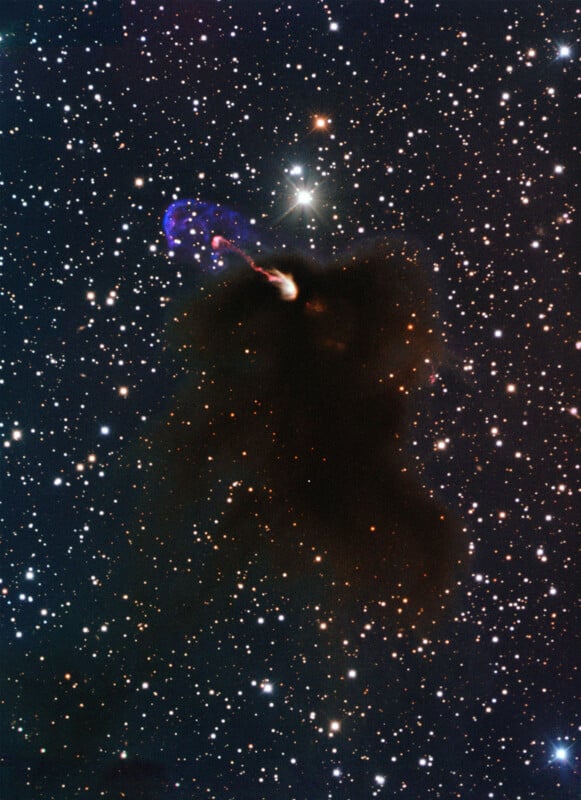
“We really only start to see that source shining at the longest wavelengths that we observed with in NIRCam (3.35, 4.44 and 4.7 microns),” he continues.
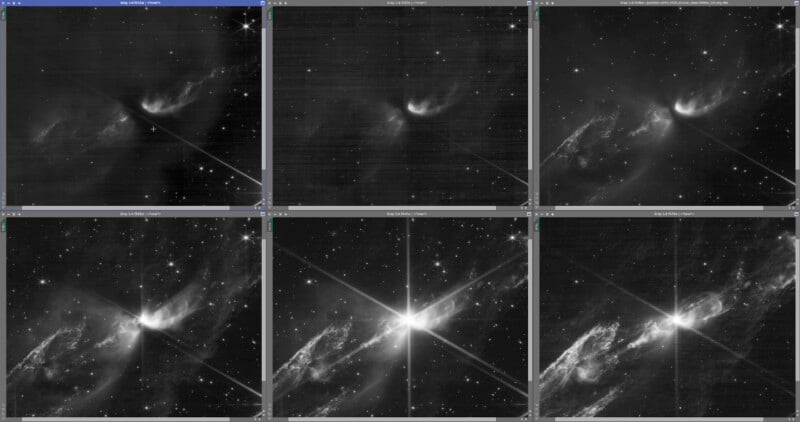
In the grid image above that DePasquale provided, he ordered the raw data by wavelength, shortest to longest, from left to right.
“Notice that the strong diffraction spike only appears at the longer wavelengths which is why it ends up appearing so strongly red in the composite image. Incidentally, you can also see how the structure of the diffraction spikes is actually wavelength dependent (which gives them their multi-color glow) — pretty cool stuff!” DePasquale adds.
Another important aspect of image processing is performing color balance after assigning filtered images to color channels. To ensure that the scientific significance of a Webb image is evident, DePasquale and Pagan must sometimes make minor tweaks to colors, contrast, sharpness, curves, and levels, while ensuring in cooperation with scientists that the images remain accurate. DePasquale and Pagan never violate chromatic ordering, and always do the best to emphasize, not change, the data that Webb’s powerful detectors deliver.
DePasquale likes to use spiral galaxies in images as his white point. “I used a bunch of the face-on spiral galaxies as my white reference for this image. It really helped get me on the right track when color balancing the image — I just had to be careful not to include galaxies that were shining through some of that dust cloud.”
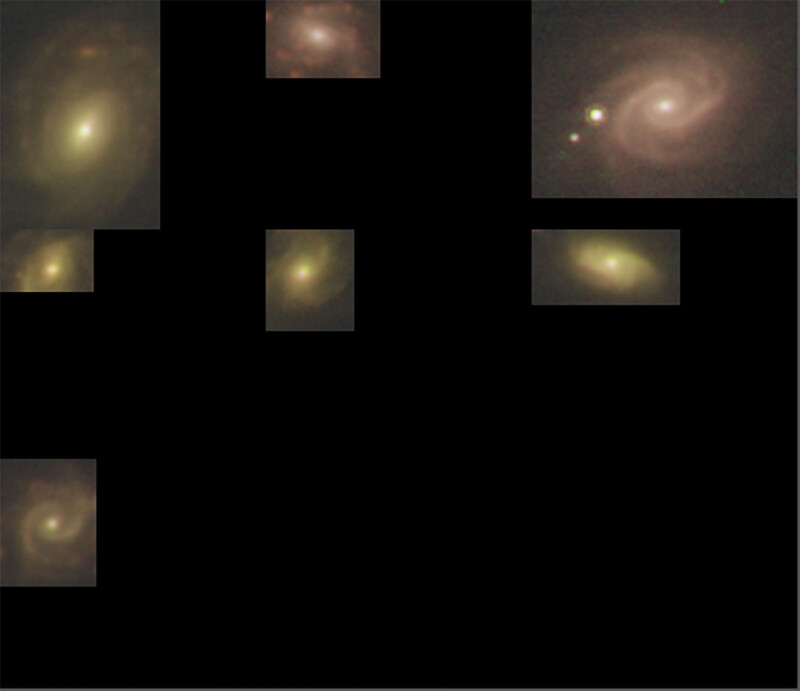
“Going back to what I had mentioned above about the dark cloud which obscures this object, you can see in those raw frames that it is very present in those shortest wavelengths which lends that part of the image its characteristically blue hues in the final composite. I was very intentional about color balancing those blue hues (and also dealing with short wavelength noise) while contrasting them with the dustier orange outer edges of the cloud and the strong red hues of the jets,” DePasquale tells PetaPixel.
“I wouldn’t describe it as a special approach, I just wanted to make sure all of that detail was easily visible — some of those features are very faint, just barely above the noise level, so it just required some additional attention to get it right,” he adds.
The semi-transparent blue cloud is a scientifically important region of dense dust and gas known as a nebula. Webb’s NIRCam allows researchers to peer through the nebula’s “gauzy layers,” which shows off much more detail of Herbig-Haro 46/47 than has been seen before while also revealing background stars and galaxies.
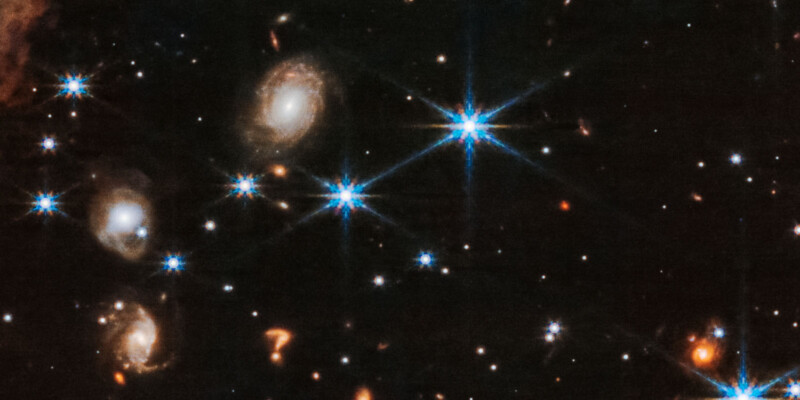
The blue nebula impacts the shapes of the orange jets propelled outward by the central stars.
“As ejected material rams into the nebula on the lower left, it takes on wider shapes, because there is more opportunity for the jets to interact with molecules within the nebula. Its material also causes the stars’ ejections to light up,” writes the Webb Space Telescope team.
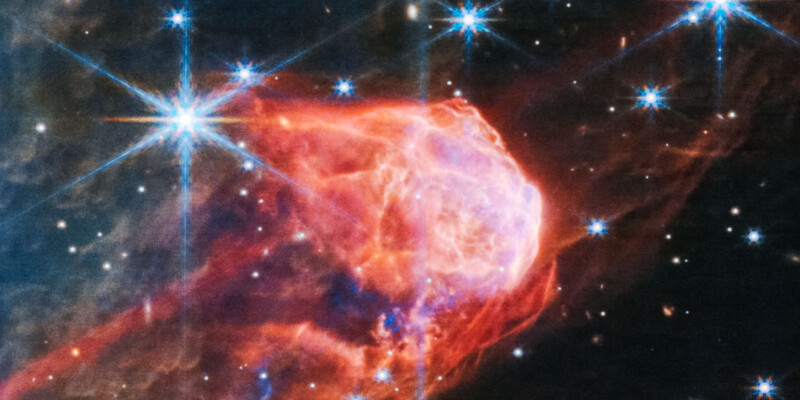
Herbig-Haro 46/47’s young age is part of what makes it such a scientifically compelling target — it is only a few thousand years old. Stars take millions of years to form. When the formation process completes, the area will be free of much of its obscuring gas and dust. Until then, “Targets like this also give researchers insight into how stars gather mass over time, potentially allowing them to model how our own Sun, a low-mass star, formed,” says the Webb team.
The pair of stars are “hungry,” so to speak. As they consume the gas and dust during their growth, stars sometimes “eat” too much material too quickly, which results in two-sided jets shooting out along the opposite axis. This settles the star’s rotation and removes some mass from the surrounding area. Over many thousands of years, these ejections regulate how much mass the stars retain.
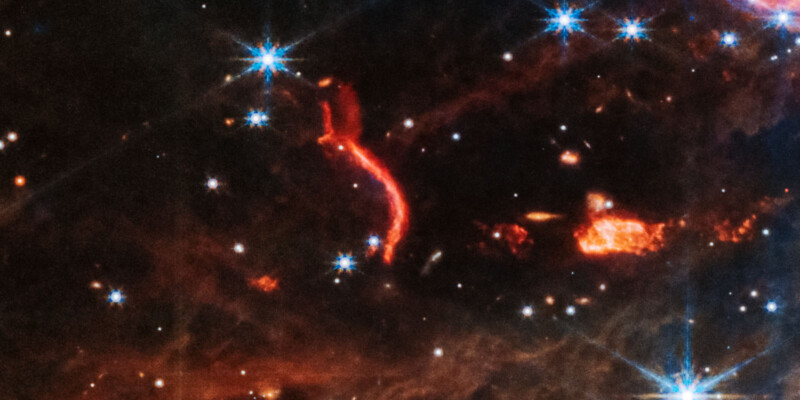
While Herbig-Haro 46/47 is the star of the show, the Webb team implores viewers also to investigate the rest of the scene.
“Take a moment to linger on the background. A profusion of extremely distant galaxies dot Webb’s view. Its composite NIRCam (Near-Infrared Camera) image comprises several exposures, highlighting distant galaxies and stars. Blue objects with diffraction spikes are stars, and the closer they are, the larger they appear. White-and-pink spiral galaxies sometimes appear larger than these stars but are significantly farther away. The tiniest red dots, Webb’s infrared specialty, are often the oldest, most distant galaxies.”
Image credits: NASA, ESA, CSA / Image processing: Joseph DePasquale (STScI)